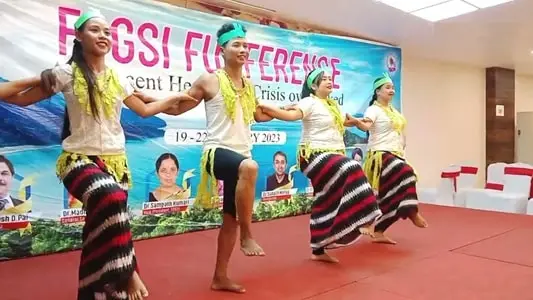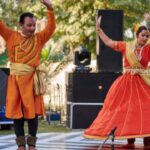Andaman and Nicobar Islands, by the side of Bay of Bengal, is the place of many wonders. Be it the beaches or the green landscapes, all the elements of these two islands mesmerize the people. But for those who want to have a taste of the culture and tradition of the place, should look into the different art forms native to the land. The islands’ cultural expressions are very much vibrant in the dance forms. For the native communities of the islands, the dances are the expressions of their traditional and spiritual understanding. Here we offer you a sneak peak of these dance forms.
1. Nicobarese Dances:

The Nicobar Islands’ natural beauty and rich culture are famous throughout India’s south. Their culture and values are expressed via dance and song. Two Nicobarese dances, “Lakshmi Dance” and “Coconut Dance,” transmit culture. Nicobarese rural culture and natural connection are eloquently shown in the “Lakshmi Dance”. Their communities’ plentiful harvests are honored in this solemn dance. Elegant dancers in traditional clothes and jewelry dance to drums and music. They dance to invoke Lakshmi, the goddess of wealth, for plenty. The “Lakshmi Dance” symbolizes Nicobarese land harmony. “Coconut Dance,” another Nicobarese favorite, is energetic. This exciting act has dancers jumping over perfectly arranged split coconut shells. The shells’ rhythmic clatter and dancers’ gestures are captivating. The “Coconut Dance” promotes community at important events and festivals. Reminding Nicobarese of their shared origin strengthens their culture.
2. Jarawa Dance:
The Andaman Islands’ secretive Jarawa tribe lives in lush woods and remote beaches. They identify with the “Jarawa Dance.” This unique tradition’s simplicity and raw beauty demonstrate the tribe’s deep connection to nature and their ancestors. Jarawa Dance is a strong tribal performance. Circle dancers glide hand in hand to traditional songs. The Jarawa’s simple dance expresses their true feelings and recollections. The tribe’s oral traditions and history are preserved as it entertains. Each Jarawa Dance dance commemorates their ancestors’ wisdom and experiences. Swaying and singing, the Jarawa relate stories of their land, struggles, and connection to nature. The dance’s beautiful motions and evocative melody preserve these tales.The Jarawa tribe see their dance as part of their identity and community, not a performance. It improves their unity.
3. Great Andamanese Dances:
Amidst the lush foliage and unspoiled beauty of the Andaman Islands live the Great Andamanese, one of the oldest tribes. Their dancing traditions reflect their deep connection to nature and the spirit realm. The “Ossu Dance” is a compelling, ancient ceremony with deep roots in their culture. The Great Andamanese love the ancient “Ossu Dance”. Rhythmic clapping and chanting create a fascinating melody that reaches the woodland spirits. This dance is holy and a way for the tribe to commune with nature and spiritual forces. The Great Andamanese “Ossu Dance” is important on many occasions. During hunting trips, the dance is practiced to invoke forest spirits. Rhythmic clapping and chanting synchronize hunters with nature, teaching them techniques and protection for successful hunting. The “Ossu Dance” often stars in woodland spirit ceremonies. For the Great Andamanese, woodland spirits are vital to their life. They thank and ask these spirits for guidance and blessings via the dance. The Great Andamanese “Ossu Dance” connects earthly and spiritual worlds. It symbolizes their respect for nature, strong connection to the trees that support them, and trust in friendly spirits. It demonstrates the tribe’s perseverance and dedication to maintaining their culture in a constantly changing environment.
4. Onge Dance:
The Andaman Islands’ Onge tribe represents simplicity and ecological reverence. Their lifestyle and values inform their unique dances, which show their good relationship with nature and community. An memorable ritual, the “Onge Dance” embodies the tribe. The dance is based on hunting and fishing, their livelihoods. Rhythmic dancing moves gently emulate these vital actions passed down through generations. Onge people do the “Onge Dance,” a precise hunting and fishing imitation. Their dance mimics the stealth and agility required to collect food in the lush forests and bountiful rivers surrounding their town. The dance praises nature and its role in their lives. The “Onge Dance” helps the tribe unwind and appreciate life. Dances enable Onge people bond and identify their community.
5. Shompen Dance:
The “Shompen Dance.” showcases the Shompen people’s rich culture in the beautiful Great Nicobar Islands. Their cultural dance combines rhythmic steps, complex hand movements, and traditional drum beats into a magnificent tapestry of heritage and delight. The “Shompen Dance” shows the tribe’s deep connection to their land and customs. A rhythmic dance with rich cultural significance, each step and hand movement is exact. These gestures demonstrate the tribe’s connection to the Great Nicobar Islands’ environment and lifestyle. This dance honors Shompen traditions during festivals and celebrations. As rhythmic steps echo, the tribe celebrates their unity, history, and connection to the environment.
Conclusion
The long running tradition of dance in Andaman and Nicobar Islands truly speak for the long nourished cultural vibe the place has. If you check properly, you will realize that the practice of dance is imbued here with stories that offer vibrant pictures of the place and times, gods and seasons, the people and love. No wonder that the dance traditions have continued to amaze people coming from the different parts of the world.
Santosh Kumar, the author behind IndiasStuffs.com, is passionate about sharing valuable insights on a variety of topics, including lifestyle, technology, and Indian culture.
Page Contents

